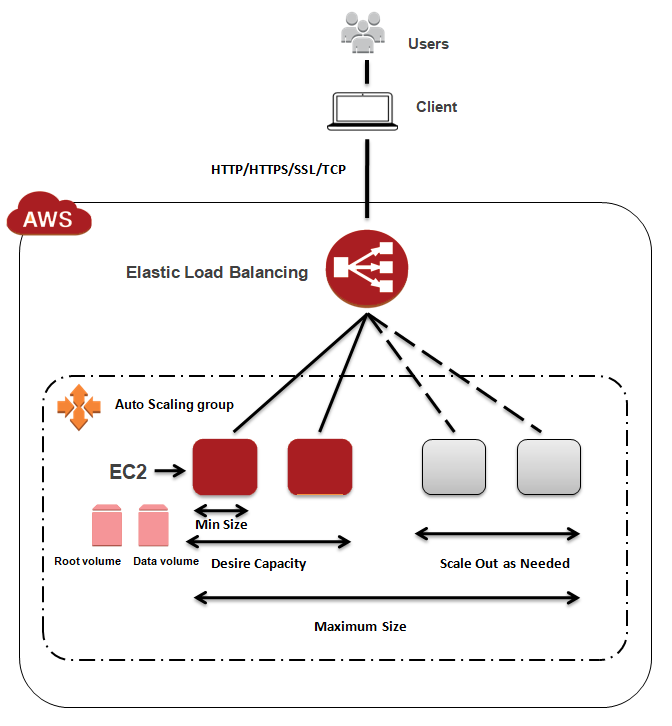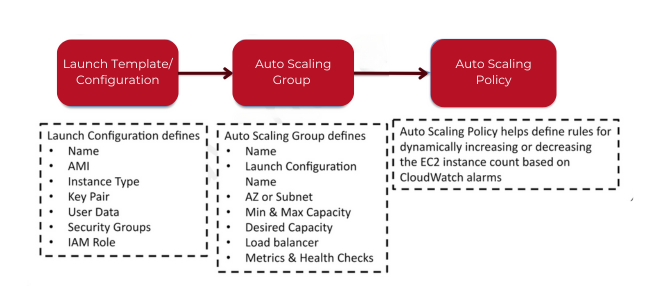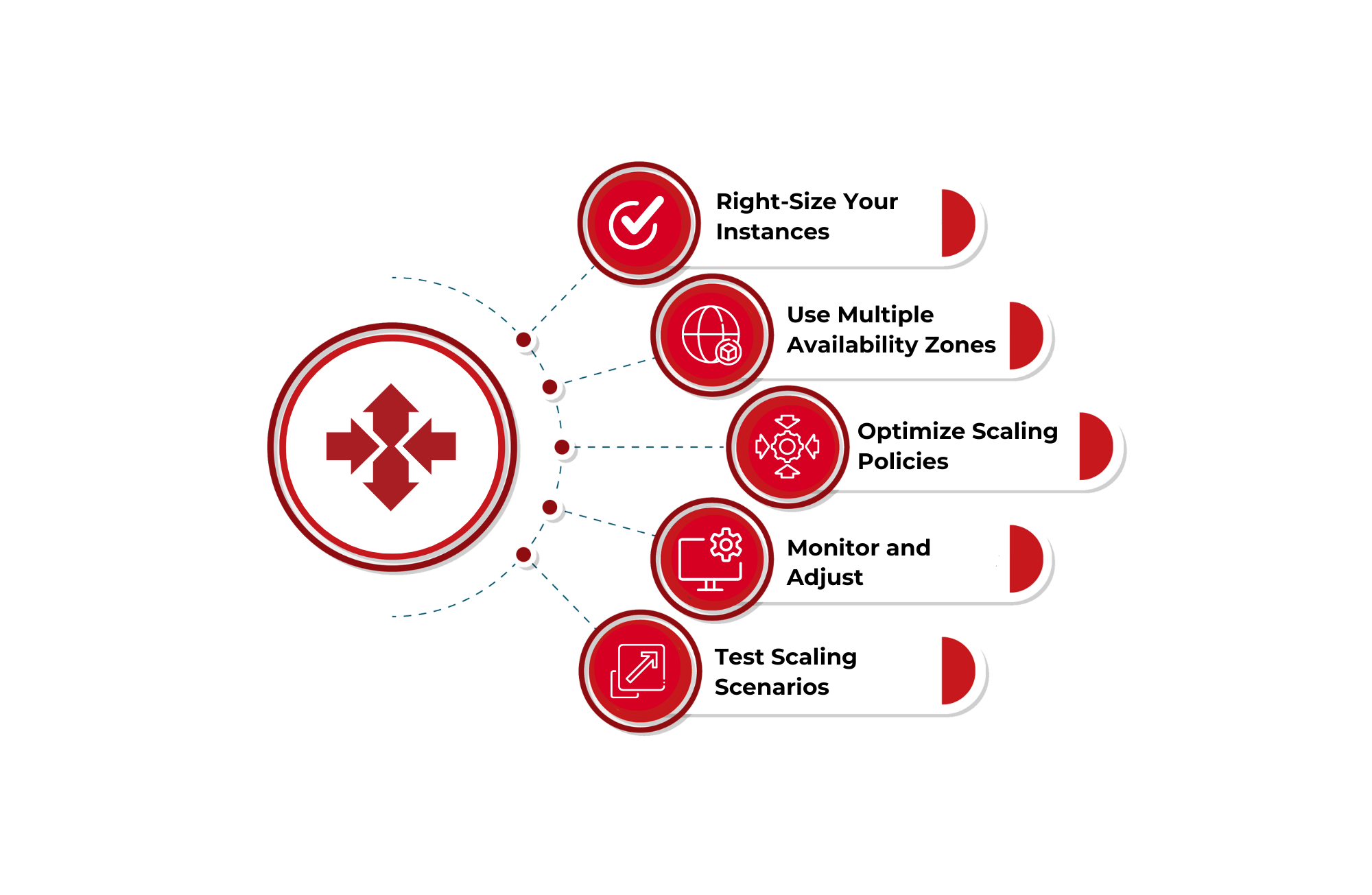What is Auto Scaling in AWS?
Published Sep 16, 2024
What is Auto Scaling in AWS?

Auto Scaling in AWS refers to the process of automatically adjusting the number of Amazon EC2 instances or other resources in your application to match the current demand. This ensures that your application has the right amount of resources at any given time, optimizing performance and cost efficiency.
Key Benefits of Auto Scaling
- Scalability: Automatically increases or decreases the number of instances based on demand.
- Cost-Effectiveness: Ensures you only pay for the resources you need by scaling down during low demand periods.
- Reliability: Helps maintain application performance by adding resources during traffic spikes.
- Flexibility: Works with various AWS services and can be integrated into your existing infrastructure.
How Auto Scaling Works

Auto Scaling uses the following components:
- Auto Scaling Group (ASG): A collection of EC2 instances managed as a group. You define the minimum, maximum, and desired number of instances.
- Launch Configuration/Template: Specifies the instance type, AMI ID, key pair, security groups, and other settings for the instances in the ASG.
- Scaling Policies: Define when and how to scale the instances based on CloudWatch metrics or scheduled actions.
Implementing Auto Scaling in AWS
Step 1: Create a Launch Template
A launch template specifies the configuration for your instances.
- Go to the EC2 Dashboard.
- Click on Launch Templates in the left-hand menu.
- Click Create Launch Template.
- Enter the launch template details:
- Name and Description: Provide a name and description.
- AMI ID: Select the Amazon Machine Image (AMI) for your instances.
- Instance Type: Choose the instance type (e.g., t2.micro).
- Key Pair: Select an existing key pair or create a new one.
- Security Groups: Choose the security groups for your instances.
- Click Create Launch Template.
Step 2: Create an Auto Scaling Group
- Go to the Auto Scaling Groups page in the EC2 Dashboard.
- Click Create Auto Scaling Group.
- Select the Launch Template created in Step 1.
- Configure the Group Size:
- Desired Capacity: The initial number of instances.
- Minimum Capacity: The minimum number of instances to keep running.
- Maximum Capacity: The maximum number of instances allowed.
- Configure the Network:
- Choose the VPC and subnets for your instances.
- Configure the Advanced Options:
- Select health check type and grace period.
- Configure Scaling Policies:
- Target Tracking Scaling: Maintain a specific metric (e.g., CPU utilization).
- Step Scaling: Define steps based on thresholds.
- Simple Scaling: Add or remove instances based on a single metric.
- Add Notifications (optional):
- Set up notifications for scaling events.
- Click Create Auto Scaling Group.
Step 3: Configure Scaling Policies
- Go to the Auto Scaling Groups page.
- Select the Auto Scaling group you created.
- Click on the Scaling Policies tab.
- Click Add Policy.
- Choose the type of scaling policy:
- Target Tracking Scaling: Define a target value for a specific metric (e.g., average CPU utilization should be 50%).
- Step Scaling: Define actions based on different thresholds (e.g., add 1 instance if CPU > 70%, add 2 instances if CPU > 90%).
- Simple Scaling: Add or remove instances based on a single threshold (e.g., add 1 instance if CPU > 80%).
- Configure the policy details and click Create.
Example: Setting Up Target Tracking Scaling Policy
python
import boto3
# Create an Auto Scaling client
autoscaling = boto3.client('autoscaling')
# Define the scaling policy
response = autoscaling.put_scaling_policy(
AutoScalingGroupName='my-auto-scaling-group',
PolicyName='TargetTrackingPolicy',
PolicyType='TargetTrackingScaling',
TargetTrackingConfiguration={
'PredefinedMetricSpecification': {
'PredefinedMetricType': 'ASGAverageCPUUtilization'
},
'TargetValue': 50.0
}
)
print(response)
Step 4: Monitoring and Managing Your Auto Scaling Group
- Use Amazon CloudWatch to monitor the performance and health of your Auto Scaling group.
- Set up CloudWatch Alarms to trigger notifications or actions based on specific metrics.
- Use AWS CloudTrail to log API activity and track changes to your Auto Scaling configurations.
Best Practices for Auto Scaling

- Right-Size Your Instances: Choose the appropriate instance types and sizes based on your workload.
- Use Multiple Availability Zones: Distribute instances across multiple availability zones for higher availability and fault tolerance.
- Optimize Scaling Policies: Fine-tune your scaling policies to balance performance and cost.
- Monitor and Adjust: Regularly review CloudWatch metrics and adjust your scaling policies as needed.
- Test Scaling Scenarios: Simulate traffic spikes to test and validate your Auto Scaling configurations.
Auto Scaling in AWS is a powerful feature that ensures your applications have the right resources to handle varying levels of demand. By following the steps outlined in this guide, you can set up and configure Auto Scaling for your applications, optimizing both performance and cost. Regular monitoring and adjustments will help you maintain an efficient and reliable infrastructure that scales seamlessly with your business needs.
 2009 - 2024 Appsbee. All Rights Reserved.
2009 - 2024 Appsbee. All Rights Reserved.